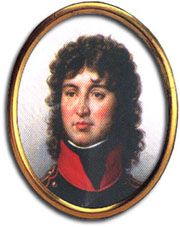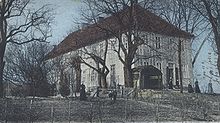Friedrich Ludwig Wilhelm von Bredow
Count Friedrich Ludwig Wilhelm von Bredow (born August 15, 1763 in Görne , † October 28, 1820 Kleßen ) was a Prussian landowner.
biography
Von Bredow came from the Brandenburg noble family Bredow . His father was Georg Friedrich Ulrich von Bredow (born April 14, 1725 in Kleßen; † February 26, 1777 in Kleßen), who married Florine Juliane Friederike von Briest on November 20, 1760 at Nennhausen Castle (* July 17, 1737 in Prenzlau ; † January 18, 1808 in Kleßen) the mother of "Friedrich Ludwig Wilhelm".
He is a direct descendant of Hans Christoph von Bredow (born November 5, 1623 in Wagenitz ; † June 1, 1691 in Spandau ) the only survivor of Bredow of the Thirty Years' War from the Wagenitz family, whose portrait and family still keep the church in Wagenitz today adorns.
"When his father Georg Friedrich Ulrich died in 1777, he was only 13 years old and was brought up by his mother and guardian" - wrote Theodor Fontane about Friedrich Ludwig Wilhelm von Bredow .
After the death of Georg Friedrich Ulrich von Bredow, his mother married two more Herr von Bredow
- on June 20, 1780 Balthasar Otto Philipp von Bredow (born April 1, 1735 in Kleßen, † September 24, 1780 in Berlin) the younger brother of Friedrich Ludwig Wilhelm's father and
- on November 29, 1781 Gebhard Philipp Christof von Bredow († May 2, 1795) the youngest brother of Friedrich Ludwig Wilhelm's father
Friedrich Ludwig Wilhelm remained their only child.
On January 15, 1785, Friedrich Ludwig Wilhelm von Bredow in Görne married Christine Luise Caroline von Otternstedt, born on July 29, 1764 in Rangsdorf / Teltow and died on November 7, 1820 in Kleßen.
Since he was the only grandson of Gebhard Ludwig von Bredow was - his five uncles were childless - he inherited the entire Klessener after the death of his father and his brothers in 1796 fief . He was now the landlord of Friesack , Kleßen, Liepe , Görne and the Vorwerk Damm in Havelland and Dicte (Dicke) (manor, parish of Kleßen). At the time of inheritance in 1796, the 33-year-old "Friedrich Ludwig Wilhelm von Bredow" and his wife already had nine children, the number of which later increased to seventeen (nine sons and eight daughters).
“He was undoubtedly endeavored to make up for everything in this regard that had been neglected in the previous generation, and since the increase in his landed property kept pace with the increase in his descendants, the moment seemed to have come to him for this wealth of property and children to give consecration by raising one's rank. The accession to the throne of Friedrich Wilhelm III. provided the external reason for this, and Friedrich Ludwig was also successful. The king raised him and all of his descendants to the Prussian count by diploma of July 6th, 1798 .
The King Murat Affair
| Brat. The son of this three times married woman: Friedrich Ludwig Wilhelm, inherits a lot together because all of his five uncles die childless; he is now quite rich and in 1798 is elevated to the rank of count. He then experienced the year 1806, when a lot was going on again. |
"In his day the King Murat affair took place, about which I have the file," wrote Fontane.
In 1806 during the Fourth Coalition War , the French troops under Marshal Joachim Murat marched through Prussia . For fear of looting , Friedrich Ludwig Wilhelm von Bredow had hidden two boxes in a hard-to-notice crate in his wine cellar at Gut Kleßen . One of his mother's boxes with her jewelry, silverware and other valuables and the other box from Friedrich Ludwig Wilhelm von Bredow himself with documents and cash.
In November 1806, the French division general Saint Hilaire and his staff took quarters in the manor house of the von Bredow family in Friesack . From this, Count von Bredow learned that Marshal Murat would come to Friesack in person and take his General Staff quarters in Friesack. Two days after General Hilaire and his staff had taken quarters in the Friesack manor house, a lack of wine was discovered, also as a result of French troops passing through.
From Kleßen, where the French were also quartered in the Bredow manor, it became known that there were still stocks there. So two cars were sent there to fetch wine. Count von Bredow learned from Murat's adjutant, a certain Colonel Manino, that two cars were already on the way to repair the lack of wine.
When the wagons arrived fully packed in Friesack, to the great horror of the Count they had loaded the two hidden boxes as well as wine. Division General Hilaire immediately took the boxes and told the protesting Count that he knew that it was state property. Through his protest, the count only managed to ensure that the boxes remained unopened until Murat arrived.
After Murat's arrival around midnight, the boxes were opened under the threat of fusillating the count in the event of false information about the owner.
I only had one key, according to the count's declaration, the other had been taken by my mother; In one box one found the family documents, some bonds and 298 thalers, 11 silver groschen deposits as well as 2735 thalers in gold and 1250 thalers in courant as well as some old gold and silver pieces, the value of which I did not specifically specify.
The count received the documents back after they had been checked and the money was put back in the box. The second box, which was undisputedly recognized as the private property of the Count's mother, had to be forcibly opened due to the missing key.
| In this box, according to the specification, there were first of all cash: 1790 thalers in gold - 850 thalers in Courant - 375 thalers in Dutch. Ducats - 83 pieces of gold medals and rare coins - 131 pieces of silver foam coins, both of which I cannot state the exact value.
Second of jewels and jewelry:
|

Murat liked the golden tobacco box with the portrait of the Great King so much that he wanted to pay the count for it. He has no intention of appropriating the valuables unpaid; the money he had at his disposal, however, was necessary for payment to the troops, the count was told. He should receive a receipt for this and have the amount reimbursed later in Berlin. The remaining valuables, including the golden tobacco box, would be loaded because of "the infamous baggage trainer" (so Murat literally) that will be pulling through Friesack in the next few days and handed over to the governor of Berlin as security.
The count finally received a receipt for the amount of money mentioned, the jewels and the silverware, in which he was assured that the government would get everything back in Berlin. This receipt was signed by both Murat, Saint Hilaire and Colonel Manino. The Count was told that the Ordonnateur en Chef (which probably meant the paymaster) had to sign this receipt. It would arrive in Friesack shortly, but that didn't happen. Half an hour after Murat's departure, one of his adjutants appeared and asked for the receipt to be handed over to be signed by the Ordonnateur en chef, who was in Fehrbellin. The adjutant reacted very indignantly to the Count's suggestion that he should come along to sign. However, he gave the count his word of honor that he would return the signed receipt the next morning, whereupon the count waived the company to Fehrbellin. After that, Count von Bredow, in spite of many efforts and scribbling, saw or heard nothing of the matter, neither of his valuables nor of the receipt.
So Fontane continues, quoting the Count: "The next day I hurried to Berlin, reported to Murat, to St. Hilaire, but I was not admitted to the first one, and the latter regretted me and said:" I hope he has the opportunity to meet me to get this back through the emperor, but this could not happen until the war was over. For God's sake I don't want to mention anything about the government and especially about the governor Clark, because Murat and Clark would be enemies and the emperor's brother-in-law would always be right. I ran the risk of being fusilated as I had no proof of receipt at all. If I wanted to call him as a witness, I could not deny that I had seen the things, but he could not claim that Prince Murat had taken all of this with him - others might as well have taken it from me. And I shouldn't have given my receipt to the adjutant at all, I should have killed him rather. ""
This brought the matter to an expensive end for the count, he lost a fortune of over 20,000 thalers.
He did not want to and could not come to terms with the loss, however, and turned to General Hilaire a few more times, who at the end said: “The matter is old and one ought to forget what could not be changed; he would have no part in it. ” After the war, the Count wrote a letter dated October 25, 1815, which describes the process, the so-called Friesack jewel robbery, via the Privy Councilor of State von Quast to the Minister Freiherr von Altenstein and asked for redress from the French state.
The reply from Minister von Altenstein to this petition is dated January 12, 1816 and reads as follows: “The French government has refused to accept any apology for what French generals or other military officers have stolen and looted, and the Allied Powers did not insist on such a demand either, because with the countless amount of looting carried out by the French armies throughout Europe during the Revolutionary Wars, all of France would not have been enough to compensate for the damage. "
His descendants
Friedrich Ludwig Wilhelm von Bredow and his wife had seventeen children, nine boys and eight girls, some of whom died as children. For the careers of some of the children, see Bredow (noble family)
Individual evidence
- ↑ a b Theodor Fontane : The little country Friesack and the Bredows - walks through the Mark Brandenburg , construction, Berlin 2005, p. 221, ISBN 3-7466-5707-5
- ↑ Henning v. Koss: The little country Friesack and the Bredows - A walk through six centuries, Märkische Verlagsgesellschaft Kiel, Kiel 1965, p. 105
- ^ New general German nobility lexicon , second volume, p. 38, by Ernst Heinrich Kneschke , in 1860 with Friedrich Voigt in Leipzig
- ↑ Theodor Fontane: The little country Friesack and the Bredows - walks through the Mark Brandenburg, pp. 209-210
- ↑ a b c d Theodor Fontane: The little country Friesack and the Bredows - walks through the Mark Brandenburg, pp. 295-298
- ↑ Henning v. Koss: The little country Friesack and the Bredows - A walk through six centuries, p. 113
Web links
| personal data | |
|---|---|
| SURNAME | Bredow, Friedrich Ludwig Wilhelm von |
| ALTERNATIVE NAMES | Bredow, Count Friedrich Ludwig Wilhelm von (full name) |
| BRIEF DESCRIPTION | German landowner |
| DATE OF BIRTH | August 15, 1763 |
| PLACE OF BIRTH | Görne , Westhavelland district, Brandenburg |
| DATE OF DEATH | October 28, 1820 |
| Place of death | Kleßen , Westhavelland District, Brandenburg |

